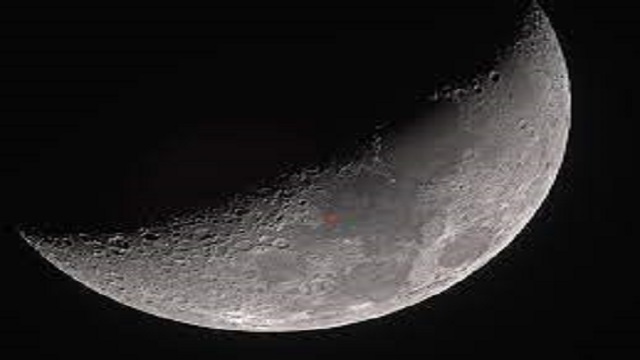Rethinking Lunar History – The New Study That Changed Everything
The Moon’s Everlasting Mystique
For millennia, humanity has looked to the Moon with wonder. Its presence in the night sky has shaped calendars, guided explorers, and inspired poetry, science, and mythology. But while we’ve marveled at its surface, the Moon’s internal story—its thermal and geological evolution—remained largely speculative for centuries. Now, a new scientific study has challenged long-standing beliefs about how the Moon cooled after its formation, potentially reshaping not only lunar science but planetary science at large.
The Traditional Model: A Quick Freeze in Cosmic Time
Before this groundbreaking revelation, the prevailing model among planetary geologists posited that the Moon, formed approximately 4.5 billion years ago from the debris of a cataclysmic Earth impact, underwent a relatively rapid cooling process. According to conventional wisdom, the lunar magma ocean—a vast molten layer that covered the Moon’s early surface—solidified swiftly as the Moon lost heat to the cold vacuum of space.
This model was supported by radiometric dating of lunar rocks brought back by the Apollo missions, as well as theoretical calculations based on heat flow and radioactive decay. Scientists long believed that the Moon had largely become geologically inert in the first billion years of its existence.
But as with much of science, new evidence has the power to challenge entrenched paradigms.
The New Study: Slower Cooling, Longer Activity
Published in mid-2025 in a peer-reviewed planetary science journal, the new study employed a combination of advanced computer modeling, thermochronological data, and high-resolution imaging from recent lunar orbiters, including China’s Chang’e series and NASA’s Artemis program satellites.
The key takeaway? The Moon’s cooling process may have taken far longer than previously assumed, perhaps stretching across more than two billion years. Instead of being a quick geological freeze, the Moon’s interior may have harbored pockets of residual heat and even minor volcanic activity for far longer than expected.
Researchers point to heat-retaining materials, such as radioactive isotopes of uranium, thorium, and potassium, embedded in the lunar crust. These elements may have played a crucial role in slowing the Moon’s internal heat loss. The study also identifies tectonic features and fissures that could indicate younger geological movements and heat dissipation patterns inconsistent with the “rapid freeze” theory.
Implications for Lunar Science
This revelation doesn’t just add a footnote to lunar history—it compels a complete re-evaluation of how scientists understand the Moon’s thermal life and internal structure. If the Moon stayed warm much longer, it opens new possibilities about:
- Extended volcanic activity: Could there have been lava flows or magma plumes well after the assumed timeline?
- Delayed magnetic field decay: A longer cooling time may explain previously puzzling data about the Moon’s ancient magnetism.
- Undetected tectonic shifts: Some faults and rilles observed on the Moon could be more recent than originally dated.
These insights directly impact lunar exploration missions. If parts of the Moon’s interior are still warm or more recently cooled than expected, future missions might consider thermal energy harnessing, targeted subsurface drilling, or even resource mapping based on geothermal gradients.
Understanding the Moon’s Internal Clocks
To determine the thermal evolution of a planetary body, scientists typically rely on several indirect but powerful tools—chief among them is thermochronology, the study of how rocks record thermal histories over geological time. In the case of the Moon, researchers used radiometric dating and thermal conductivity modeling, enhanced by modern satellite imaging and sample analysis.
The central method employed in this new study was a refined version of the uranium-lead (U-Pb) dating technique, which measures the decay of radioactive isotopes to determine when lunar minerals last cooled below critical temperatures. These minerals act as “natural thermometers,” recording the moments they solidified or recrystallized. The surprising results? Many samples suggested much later cooling dates than anticipated—sometimes by up to 700 million years beyond previous models.
Global Collaboration: Data from Earth and Space
One major factor that lent credibility and weight to this new research was the breadth of data sources:
- Apollo Mission Samples: Scientists revisited well-preserved lunar rock samples brought back by Apollo 14 and Apollo 17, using newer instruments to analyze isotopic and thermal signatures that had gone undetected in the 1970s.
- Lunar Reconnaissance Orbiter (LRO): NASA’s long-running orbiter supplied thermal emission data over a period of several lunar years. These readings allowed scientists to map heat flow and conductivity in various regions, especially near volcanic plains like Mare Imbrium and Oceanus Procellarum.
- Chang’e 5 Samples: China’s Chang’e 5 mission returned the youngest lunar basalt samples ever collected. Radiometric dating of these samples revealed that volcanic activity persisted on the Moon as recently as 1.96 billion years ago, contradicting prior theories that the Moon’s volcanic era ended 3 billion years ago.
- Artemis-Pathfinder Seismic Arrays: NASA’s Artemis program, in partnership with ESA and JAXA, deployed advanced micro-seismic arrays near the lunar south pole in 2024. These instruments detected low-level thermal contraction and micro-tremors, providing fresh clues about internal heat pockets and the slow cooling process still ongoing in localized regions.
What Slower Cooling Tells Us About Lunar Evolution
This broader, more comprehensive approach has dramatically changed the scientific picture of the Moon. Here are some of the top-level conclusions drawn from the research:
- Heterogeneous Cooling: The Moon didn’t cool uniformly. Some regions—particularly on the near side—retained heat for far longer, likely due to higher concentrations of heat-producing radioactive elements.
- Prolonged Geological Activity: The extended thermal lifetime supports the possibility that the Moon was geologically “alive” longer than we thought. This doesn’t necessarily mean massive eruptions, but rather episodic, isolated volcanic or tectonic events continuing late into lunar history.
- Crustal Anomalies: Areas like the Procellarum KREEP Terrane (rich in potassium [K], rare earth elements [REE], and phosphorus [P]) are now believed to have significantly delayed local cooling. This is important because KREEP-rich areas are key targets for future mineral resource exploration.
- Magnetism Mystery: A slower cooling process may also explain the Moon’s surprising magnetic record. Magnetic fields usually arise from the motion of molten iron cores, which require internal heat. The Moon’s ancient rocks show traces of magnetism much younger than expected—implying a still-partially molten core far later in its life than formerly assumed.
Skepticism and Peer Review: Science Under Scrutiny
Despite the enthusiasm surrounding the new findings, not all scientists are convinced. Several experts, particularly from the older generation of planetary geologists, have urged caution. They argue that alternative interpretations of the data could exist, such as impact-related reheating events or surface insulation anomalies that skew thermal readings.
However, the study has already undergone rigorous peer-review and was published in the Journal of Planetary Interiors, one of the most respected journals in its field. The team behind the research is a global consortium of experts from NASA, the European Space Agency, the Chinese Academy of Sciences, and MIT.
From Research to Roadmaps: How This Study Shapes Future Missions
The implications of this study are already influencing strategic planning for future lunar missions:
- Resource Mapping Missions: Missions like Artemis III and Chang’e 6 are being recalibrated to include thermal anomaly mapping as part of their goals. If the Moon has heat-rich zones, they could be excellent candidates for future human bases or in-situ resource utilization (ISRU) operations.
- Astrobiological Interest: While the Moon is considered biologically sterile, a warmer subsurface for longer periods raises speculative interest in subsurface extremophile habitats—or at the very least, comparative models for astrobiology on icy moons like Europa or Enceladus.
- Lunar Drilling Tech: Engineers at JAXA and ISRO are reportedly working on ultra-light thermal drilling rigs that could be deployed in future missions to probe for geothermal gradients.
Why Compare? The Moon as a Planetary Reference
In planetary science, the Moon is often treated as a “control sample”—a relatively simple, tectonically inactive body that has preserved its geological history like a frozen archive. Unlike Earth, which undergoes constant renewal through plate tectonics, or Mars, which saw episodic climate shifts, the Moon provides a relatively undisturbed narrative of planetary evolution. But the new findings that suggest the Moon cooled more slowly than believed challenges this simplicity. It now offers deeper comparisons across the solar system.
By aligning the Moon’s updated thermal history with the evolution of other celestial bodies, scientists can better understand:
- Why Earth retained its molten core while the Moon cooled off (or so we thought).
- Why Mars has localized magnetic anomalies and extinct volcanoes.
- Why Mercury has a strong magnetic field despite its small size.
The Moon, once a planetary afterthought, is becoming a key comparator in the science of thermal evolution and magnetic field generation.
Mars and the Magnetic Enigma
Mars is cold, dry, and geologically quiet—but not always. The Red Planet was once warm and volcanic, with a thick atmosphere and flowing water. It even had a global magnetic field, generated by a liquid iron core, much like Earth’s today. But somewhere between 3.5 and 4 billion years ago, this magnetic field vanished. Scientists had long believed that Mars cooled faster than Earth, which explained the collapse of its magnetic shield and atmosphere.
However, if the Moon—a smaller body than Mars—retained heat longer than thought, it begs a question: Did Mars also retain more heat than assumed?
Recent seismic and gravitational data from NASA’s InSight lander suggest that parts of Mars’ core may still be partially liquid. If the Moon’s thermal history has been underestimated, it’s likely the same has occurred with Mars. This has huge implications for Mars colonization, underground water exploration, and resource harvesting.
Mercury: The Survivor of the Sun’s Heat
Mercury presents one of the strangest paradoxes in the solar system: it’s tiny and close to the Sun, yet still has a magnetic field. For years, this confused scientists. A small body like Mercury should have cooled and solidified billions of years ago, killing its dynamo (the engine that produces magnetic fields).
Now, with the Moon’s cooling revision, planetary scientists are revisiting Mercury’s models too. If the Moon’s crust acted as an insulator, preventing efficient heat loss, could Mercury’s extremely thin mantle have done something similar? Could radioactive elements have lingered, delaying cooling? These comparisons are helping scientists rebuild thermal models for every rocky planet in the inner solar system.
The ESA-JAXA BepiColombo mission is currently en route to Mercury and will provide crucial magnetic and thermal data, which will be evaluated in the light of the Moon’s slower cooling process.
Earth: The Anomaly, or the Archetype?
Earth is the only planet known to have active plate tectonics, a molten core, and a robust magnetic field. These dynamic properties have long separated Earth from its lifeless neighbors. But if the Moon—our planetary sibling—retained more internal heat than once thought, perhaps Earth’s longevity isn’t so unique.
Geologists now suspect that Earth’s internal heat may not be purely sustained by radioactive decay, as previously assumed. Residual heat from the planet’s formation—called primordial heat—might also be more significant. The Moon’s updated heat-retention timeline supports this theory.
Another possibility is that large-scale impacts helped preserve internal heat. The Moon, Earth, and Mars all bear impact scars, but Earth’s thicker atmosphere and ocean coverage may have insulated it more effectively.
Thus, rethinking the Moon’s cooling also reframes Earth’s internal dynamics and our assumptions about what makes a planet geologically “alive.”
Beyond Our Backyard: Implications for Exoplanets
Perhaps the most forward-looking impact of this research is its implication for exoplanet studies. Thousands of planets have now been discovered beyond our solar system, many of them rocky “super-Earths” with higher mass and unknown thermal properties.
If small rocky bodies like the Moon can stay warm longer, it follows that super-Earths—which cool more slowly due to their size and gravity—could remain geologically active for billions of years longer than we imagined. This boosts the odds of finding:
- Exoplanets with magnetic fields, which protect atmospheres and increase the chance of habitability.
- Subsurface oceans or geothermal regions, which are potential habitats for alien life.
- Volcanic or tectonic activity, which releases greenhouse gases and regulates temperature over time.
By studying our Moon’s thermal evolution, scientists now have a more refined framework for assessing habitability across the cosmos.
The Moon’s newly discovered thermal patience isn’t just a twist in lunar history—it’s a revelation with planetary-scale consequences. From Mars and Mercury to exoplanets light-years away, our understanding of how planets live, evolve, and die is undergoing a quiet revolution—one that began with a few old rock samples, a few new satellites, and a Moon that refused to cool as quickly as we once believed.
Rethinking the Lunar Underground
For decades, space agencies and researchers planning lunar habitats assumed that below the Moon’s surface lies inert, cold rock, long frozen since the end of its volcanic era. But recent studies revealing a slower-than-expected cooling process are forcing engineers and mission planners to rethink this assumption.
If the Moon’s interior retained heat longer—possibly even harboring localized warm zones deep beneath the crust—that changes the blueprint for:
- Habitat construction
- Mining operations
- Power sourcing
- Radiation protection strategies
- Scientific drilling
This isn’t just about thermal curiosity. It directly influences how long and how safely humans can live and work on the Moon.
Thermal Zones and Base Placement
NASA’s Artemis program and private ventures like Blue Origin and SpaceX have proposed long-term lunar bases—particularly near the Moon’s south pole, where water ice has been detected. But with the new cooling models, researchers now must ask:
Could residual heat in certain subsurface regions pose risks or opportunities?
If shallow thermal pockets exist, engineers might need to:
- Reinforce underground habitats with insulation and structural barriers against rising heat or pressure.
- Exploit natural geothermal gradients to generate energy—something once dismissed as unlikely on the Moon.
- Avoid digging or tunneling into thermally unstable zones.
This transforms site selection from a purely topographic and solar exposure exercise into a geothermal mapping challenge.
Mining for Resources: A Warmer Moon Means More Potential
Another massive implication is for lunar resource utilization. The Moon is known to contain:
- Rare Earth elements
- Helium-3 (a potential nuclear fusion fuel)
- Basaltic rock rich in useful metals
- Volatile compounds locked in polar shadows
A warmer interior implies a slower crystallization of magma—which geologists say could lead to better-concentrated mineral veins. This is similar to how Earth’s geothermal systems transport and deposit valuable metals in crustal fractures.
In other words, the Moon may be more mineralogically diverse and richer in deposits than previously thought.
NASA, ISRO, and ESA are already developing robotic drills and autonomous rovers for deep-core mining, and this research will guide where and how deep they dig.
Radiation and Thermal Protection: A Two-Front Challenge
One of the biggest threats to lunar explorers is radiation. The Moon has no magnetic field and no atmosphere, leaving its surface exposed to:
- Solar particle events (SPEs)
- Galactic cosmic rays (GCRs)
- Ultraviolet radiation
Early base designs suggested subsurface shelters or lava tubes as protection. However, a slower cooling Moon raises a critical concern:
What if those underground chambers are not as cold—or stable—as we assumed?
Thermal gradients in the crust could increase risks of ground shifts, vapor escape, or material fatigue, especially in older lava tubes or melt basins. Engineers may now need to combine radiation shielding strategies with temperature monitoring systems, using advanced materials like:
- Regolith-based 3D-printed composites
- Phase change insulation
- Boron-rich concrete for dual radiation and heat resistance
These adaptations will be vital for permanent or semi-permanent lunar stations.
Lunar Agriculture and Life Support Systems
If deeper soil retains heat, and possibly trace water in thermally trapped pockets, it could reshape lunar agriculture efforts. Scientists have long dreamed of growing crops in:
- Hydroponic systems
- Enclosed regolith-based greenhouses
- Subsurface biomes
But soil temperature and hydration levels are critical to plant survival. If parts of the lunar regolith are warmer than expected—even a few meters deep—it could:
- Reduce heating costs for underground greenhouses
- Allow better root zone regulation
- Open doors for subsurface microbial research
This would dramatically increase sustainability for long-term missions, especially as Earth resupply becomes less frequent over time.
Seismic Activity: Could the Moon Still Quake?
Apollo-era instruments detected “moonquakes”, many caused by tidal forces or thermal expansion. But if the Moon stayed warmer longer, some internal motion may still persist, especially near areas where residual magma may have cooled unevenly.
Seismic mapping from NASA’s upcoming Lunar Vertex and Farside Seismic Suite missions will reexamine the Moon’s tectonic state. And if confirmed, new lunar structures will need:
- Shockproof anchoring systems
- Real-time vibration monitoring
- Flexible construction designs
This also has implications for drilling and tunneling, which could trigger quakes if heat-sensitive zones are breached.
Helium-3 Extraction: A New Age of Lunar Fuel
Helium-3 is one of the most promising fusion fuels, and the Moon holds it in abundance within its upper crust—delivered by billions of years of solar wind. A warmer crust affects how Helium-3 behaves:
- Is it locked deeper than we thought?
- Are there pockets of concentration created by geothermal flows?
If so, fusion fuel harvesting becomes economically viable, and the Moon may become Earth’s off-world energy reservoir in the 22nd century.
The Moon’s unexpectedly slow cooling isn’t just an academic revision—it’s a game-changer. From habitat architecture and mineral wealth to agricultural conditions and radiation strategies, nearly every aspect of future lunar missions must now account for a thermally active past that may still echo underground.
What we thought was a dead world, frozen solid, is now a more complex partner in our push to become a spacefaring civilization. And in this complexity, we find both caution and opportunity—making every step on lunar soil a step into uncharted science.
Also Read : Malcolm-Jamal Warner’s Death Sparks Nationwide Mourning in Black Community








